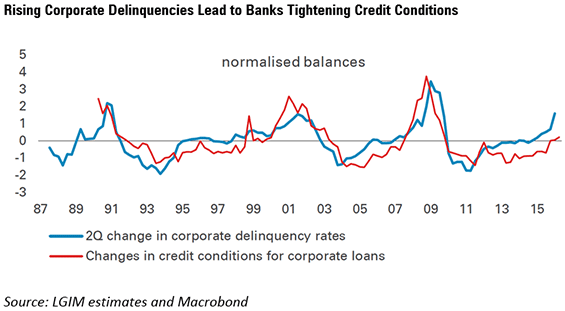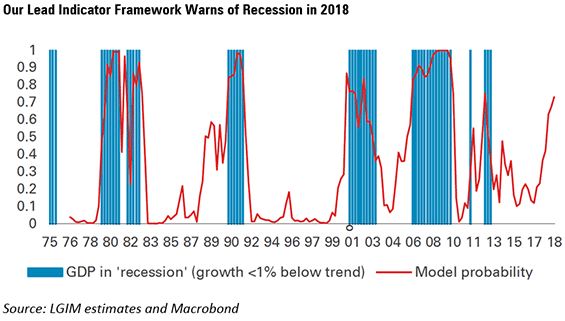The FED can't raise rates again.
There is too much unserviceable debt when these rates get raised.
They can bark all they want but it won't happen, it's all a big show, similar to the Donald Trump show. By all accounts the US is heading back into a recession over the next couple of years if they don't re-inflate the economy with QE4 or similar.
Look what has happened to commodity prices, especially oil after the series
Of QE initiatives post gfc. It spiked to over $100 pb for a few years. QE would be the best scenario for the sharemarket and commodities IMO, just run for the hills before the house of cards comes tumbling down.
Recent informative article I read;
Stronger growth boosts profits. This helps companies service their loans. And a decline in delinquencies, loans greater than 30 days overdue, makes banks more confident about making new loans, boosting growth.
We worry this virtuous cycle is turning vicious in the US. The crisis in emerging economies and the collapse in domestic oil investment have hurt economic growth.
This, combined with a stronger dollar and a tight labour market, has pushed profits lower.
Moreover, the Fed has also started to raise interest rates and so we've seen corporate delinquencies jump.
To cap it all, banks are reporting they're tightening credit conditions for corporate clients. We worry this can become self-reinforcing.
The benign view is the bad loans are concentrated in the oil exploration sector--so as long as the rest of the economy holds up, delinquency rates will fall back after these oil companies go bust.
The problem with this analysis is banks do not hold equity in winners. Instead, they only make loans to winners and therefore get the same interest payment from them regardless of their profitability.
Consider, for example, a two-sector economy consisting of oil explorers and airlines.
A halving of the oil price would cause bumper profits for the airline sector as their biggest cost—fuel--collapses. Yet for oil explorers, the difference between $100 and $50 oil could be one of survival versus bankruptcy.
How does this affect the bank? It gets the same fixed 5 per cent interest payment from the airline, no matter what the oil price is.
But a low oil price causes the oil explorer to become bankrupt and the bank makes a big loss on that loan.
As the bank licks its wounds, it becomes more cautious about making further loans. This explains why changes in corporate delinquencies tend to lead changes in credit conditions.
So, the recent jump in both US corporate delinquencies and tightening credit conditions is worrying as we could be heading into a downward spiral.
We also worry bad loans could spread to other sectors as firms get squeezed by a combination of low unemployment and higher interest rates
The US profit share looks to have peaked and not just because of energy.
Analysts at JP Morgan have shown how profits excluding commodities have moved sideways over the past year, just as ex-financial profits moved sideways in 2007 and ex-tech profits moved sideways in 2000.
The culprit instead seems to be a tight labour market squeezing profit margins: unemployment has fallen to cyclical lows and firms report acute recruitment difficulties, while wage inflation and core inflation have both picked up over the past year.
In the short run we expect US core inflation to stabilise, as we estimate it takes around 18 months for the full effect of lower commodity prices and a stronger dollar to feed through.
But in 2017 the Fed could face a real dilemma--"damned if you do, damned if you don't"--that is classic late cycle.
With GDP growth expected to hold up in the short term, the labour market will remain tight in 2017.
Rising labour costs should push up core inflation as the drag from lower commodities and a stronger dollar drops out, so the Fed will be under pressure to raise interest rates to slow growth and contain inflation.
But a tight labour market will also be squeezing profit margins. And rising interest rates will further impair indebted companies' ability to service their loans.
Rising corporate interest gearing should cause more corporate delinquencies, which in turn should lead to credit conditions tightening further in 2017--even if we assume house prices continue to rise rapidly and the labour market remains strong.
In football terms, this situation is analogous to a team chasing a losing game when its star player gets injured.
What does the manager do? Keep the player on the pitch or substitute him for a fitter but less skilful player?
This is the problem central banks faced in 2007. If they hiked rates, they exacerbated the credit crunch, but if they left rates unchanged, inflation would have got out of control.
We don't think the US economy is about to get "sent off" with a straight red card. The recovery started in 2009 and our credit framework suggests a recession is plausible in 2018, so we're in year seven out of nine.
Perhaps the manager will make the right substitution and we'll score an equaliser and get extra time. But you've been warned: Yellow card.
- Forums
- ASX - By Stock
- QE4 coming
The FED can't raise rates again. There is too much unserviceable...
Featured News
Add FAR (ASX) to my watchlist
 (20min delay) (20min delay)
|
|||||
|
Last
49.5¢ |
Change
-0.005(1.00%) |
Mkt cap ! $45.74M | |||
| Open | High | Low | Value | Volume |
| 50.0¢ | 50.0¢ | 49.5¢ | $8.846K | 17.69K |
Buyers (Bids)
| No. | Vol. | Price($) |
|---|---|---|
| 1 | 89158 | 49.5¢ |
Sellers (Offers)
| Price($) | Vol. | No. |
|---|---|---|
| 50.5¢ | 97696 | 2 |
View Market Depth
| No. | Vol. | Price($) |
|---|---|---|
| 1 | 89158 | 0.495 |
| 1 | 99999 | 0.490 |
| 2 | 104597 | 0.485 |
| 4 | 260000 | 0.480 |
| 1 | 100000 | 0.475 |
| Price($) | Vol. | No. |
|---|---|---|
| 0.505 | 88712 | 1 |
| 0.510 | 100000 | 1 |
| 0.515 | 120000 | 2 |
| 0.520 | 149917 | 3 |
| 0.525 | 118000 | 2 |
| Last trade - 15.59pm 19/08/2024 (20 minute delay) ? |
Featured News
| FAR (ASX) Chart |






